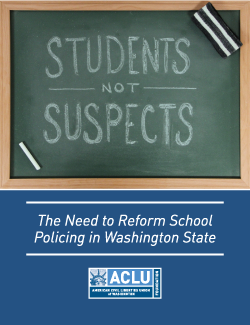Student Resource Officers Can’t Be Standardized
Hello readers, I would like to share with you that after further research some school districts have recently seem improvements of student-police relations from progressive SRO programs. While these practices could be adopted everywhere, the is no national standard or policy that SRO's must abide by. This is because they are agents of community oriented policing which will have different focuses and policies from region to region.
As addressed earlier on this blog site SRO’s have increased dramatically since shootings in the 90’s. One source told me that 42% of public high schools now have an SRO in them. While this may look like more safety from the outside looking in, students are still being criminalized for non-criminal behavior. As Dewey Cornell, a psychology professor at the University of Virginia put it, “If you put police officers in schools as guards, they will have little to do and they will not be in the high crime areas of our community where they are needed the most.” In an MSNBC article from 2013, the Obama adminstration gave $45 in federal grants to employ 356 new SRO's. It doesn’t look like there will be an insufficient amount of SRO’s any time soon. So if we have so many police in school, what are they doing to improve school safety?


Despite a the terrible tragedy of the Parkland Shooting in Broward County, Florida, all three of these schools have seem positive benefits from progressive programs. In Clayton County, weapons on campuses decreased by 70% and other positive effects were manifested but I think the greatest stat from this is that graduation rates have increased by 20%. Broward County says in one school quarter suspensions were down 66 percent and expulsions down by 55%. In Denver, total suspensions were down 60% and referral of youth to law enforcement of all youth, including youth of color, dropped 57%.



First Photo: www.pixel.nymag.com/imgs/daily/intelligencer/2018/02/22/22-school-crime-rates.nocrop.w710.h2147483647.2x.jpg
Second Photo:www. encrypted-tbn0.gstatic.com/images?q=tbn:ANd9GcRZXS2iiPltOZgpVYpA4b-9meF-5gqXhV_QrgPG1pmHG4pA2rPX
I found it interesting that only 42% of schools have an officer. I thought that number would be higher. One question that I had was when you are giving the stats on Clayton County, Broward County and Denver I didn’t know what these stats were about until I really read the paragraph before closer. Maybe when you are giving the stats in this paragraph you could reintegrate that those numbers represent the stats after schools implemented a police program to clarify. I agree with you about the conflicts of having police officers in schools but it is nice to see some positive statistics about them.
ReplyDeleteThis comment has been removed by the author.
ReplyDeleteI like that you picked this topic, i feel like this is a very big topic now a days. There are a lot of school shootings and maybe having someone in the school that makes the kids feel safer would help. i found it interesting that not every school district has officers when i went to school every school around me had at least one. Do you really think that having an officer in the school will help though? I know a lot of schools that have police officers in the school and kids still bring weapons to school or do stuff that they shouldnt be doing. Will having an officer in every school make the kids feels safer or actually make them safer.I do agree that every school should have an officer.
ReplyDeleteBen,
ReplyDeleteI really found this blog post just as entreating as the first. I really like how you emphasized the important of SRO's in schools. It actually shocked me how different rates of crime in schools decreased to the presents of and SRO. I also found it crazy that only 42% of schools have an SRO I feel like there needs to be more. Your post got me thinking about a few different questions for example Why don't more schools have an SRO? Is there a need for SRO's in schools and the budget just isn't there for the school to be able to have one? I agree with the fact that having them in schools is important that by doing so schools have been on their way to becoming a much safe place for our children. Thanks for sharing your thoughts.
-Alina Fuentez